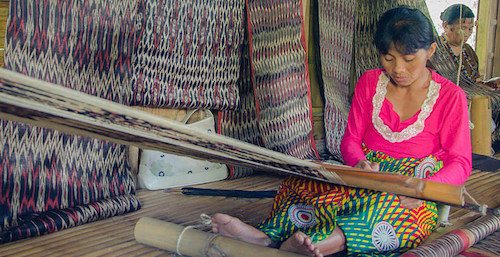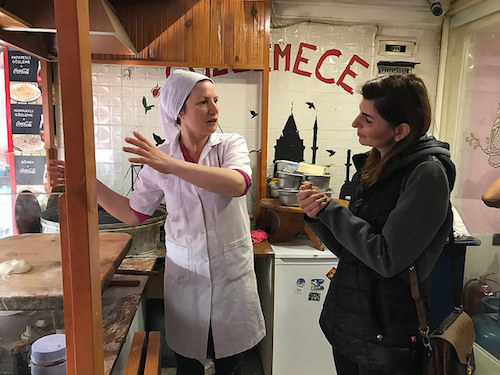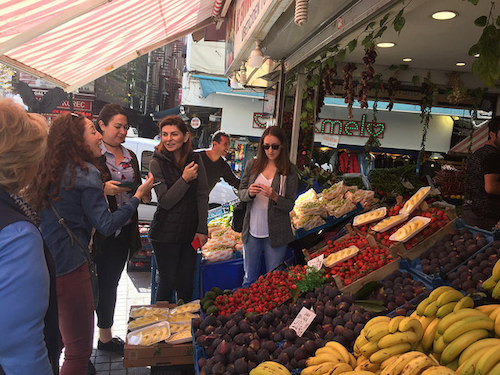

By Dan DeValve
The decision by small and medium enterprises (SMEs) in emerging economies to enter an international market is a key step in their maturation. For some SMEs, the move is necessary for survival in a competitive local economy, while for others it’s a logical next step for a successful and growing organization.
Kim Ian’s Dairy Delights is an excellent example of how a locally successful business in an emerging economy, in this case, the Philippines, approaches the decision to transition to the regional or international market. In 2015, I traveled to the Philippines and visited the town of Los Baños, home to many agribusinesses and located near the capital city of Manila. One of the town’s successful small businesses, Kim Ian’s Dairy Delights, had rapidly grown its production of goat milk-based cream cheese. It now faced a decision between scaling up the business to reach supermarket chains in Manila, or remaining in the much smaller niche market in Los Baños. The business owner recognized that expansion of the business would require reallocation of resources to pay for marketing and logistics, significant financial investment and risk, and a strategy for healthy growth of the company. Despite the risks, ultimately the namesake owner decided that their success hinged on a transition to the larger Manila market.
“Foreign market entry is considered as a key strategy to grow and survive over longer periods of time for SMEs,” according to a recent study on Bangladeshi SMEs in the International Marketing Review. In emerging economies with vibrant entrepreneurship sectors, such as the Philippines, the decisions made by these business leaders are instructive and can be illuminating for SMEs in other emerging economies.
While entering the export market has clear benefits, it is a major risk for a small business and can easily result in failure. As key factors of success, a recent study in the Journal of World Business stressed the importance of international business experience on the part of the SME owner, the strength of the home country’s institutional support for SMEs, and whether the SME is using the proper business model. If they have the advantage of institutional support, such as the local government or a business incubator, business owners can also utilize a “learning-by-exporting” model to make the transition, as highlighted in a previous NextBillion post.
A selection of three recent case studies published by WDI Publishing, part of the William Davidson Institute, highlights several issues commonly faced by Philippine SME owners as they consider a move to the international market. These three cases, which are available for free, were among a total of 94 published as part of a four-year project focused on training university faculty in the Philippines on how to teach and write business case studies. WDI implemented the project, in partnership with RTI International and the United States Agency for International Development (USAID).
A business case study is a documented analysis of a real-life business scenario, typically one in which the protagonist must make a crucial decision affecting the success of the business. As a teaching tool, cases provide students with “real-life” experience in decision-making and strategic thinking. As Philippine faculty engaged with a local business and identified a dilemma to feature in their cases, we noticed many focused on whether or not SMEs in the Philippines should enter international markets.
A common theme runs across these three cases. Each business is established in the domestic market with varying degrees of success, and each owner recognizes the advantages to be gained in exporting. Despite the potential benefits, the business owners must also consider the risks, especially adjusting an existing business model and scaling up production capacity to meet the demands of a new market.
Because the case studies were published in 2016 and 2017, WDI was able to review the various decisions ultimately made by these business owners and the ensuing results:
As this view inside three organizations showcases, SME owners can find it difficult to make the transition from domestic to international markets due to a lack of business experience. However, as illustrated in the cases of IPMC and REFMAD, government support for SMEs during this process is crucial. It can include assistance, such as the coordinating of trade fairs to help business owners make new connections, entrepreneurship training programs to provide business owners with the tools needed to scale a business, or even simple promotion of the business to potential customers.
As in the case of GFCP, if the business expertise, proper business model and ability to scale up production are absent, and the business has little to no external support, the idea of entering the international market remains only a dream.
Note: This article was written by Daniel DeValve, a senior project manager for grants management at WDI. The article originally appeared on NextBillion, which is managed by WDI.
Photo by I Travel Philippines via Flickr

A member of the LIFE project consortium speaks with a Turkish business owner of a small crepe restaurant about her perspective on hiring people of different cultures, including Syrian refugees.
Two WDI representatives traveled to Turkey earlier this month as part of the Institute’s work on a project, led by the Center for International Private Enterprise (CIPE), that aims to develop sustainable livelihoods in the food sector for Syrian refugees and their host communities.
WDI Senior Project Manager Kristin Babbie Kelterborn and WDI Faculty Affiliate Peter Scott traveled to Istanbul and Gaziantep to collaborate with other project partners to conduct a mapping and discovery process to understand the specific needs of the target populations.
The project, “Livelihoods Innovation through Food Entrepreneurship,” or LIFE, will set up Food Enterprise Centers (FECs) in the two Turkish cities to train 20-40 entrepreneurs at a time on how to run food-based businesses. The centers will serve as incubators, and in addition to a kitchen, will feature space for meetings, co-working and training.
Scott has experience teaching entrepreneurship courses at various universities, conducting entrepreneurship training programs in Bahrain and Papua New Guinea, and has advised over 20 start-ups as a business development consultant. Kelterborn supports WDI’s Entrepreneurship Development Center (EDC) and brings her academic training in the sociology of food and agriculture, as well as her previous experience providing business development support to food and agriculture-based businesses at an accelerator, to the project.
During the trip, Kelterborn and Scott participated in a mentorship environment assessment, and developed a summary of the trip with a detailed action plan for upcoming program phases.

Members of the LIFE project consortium visit a produce stand in Turkey and interview the owner on how a green grocer sources his produce. The team sought his perspective on how he could potentially benefit from the LIFE Food Enterprise Center.
WDI will also develop tools for establishing an entrepreneur mentoring program at the FECs. Finally, WDI is represented on the Steering Committee of the LIFE project. In this capacity, the Institute will provide entrepreneurship-related advice and expertise on the structure and setup of the FECs and contribute ideas for a local ownership model to promote sustainability beyond the lifecycle of the program, among other duties.
The FECs will also provide workforce development training for an anticipated 1,000 workers in the food sector covering topics such as food and beverage management, procurement, and customer service skills.
In addition to CIPE and WDI, other members of the project consortium are: Union Kitchen; IDEMA (International Development Management); and, The Stimson Center.
Turkey has the largest refugee population in the world, including more than 3 million Syrians, a number that stood at about 170,000 at the end of 2012. Most of the Syrians entering Turkey have fled the country’s civil war. Formal unemployment among the refugee population is high, and tensions have flared between refugee and citizen communities.
The food sector in Turkey is a promising pathway for Syrian refugees to strengthen their livelihoods, ultimately benefitting the Turkish economy and society. Using food as a means of cross-cultural engagement and understanding, known as “gastrodiplomacy,” is a main focus of the LIFE project.
“Food is an effective way to foster cross-cultural connections,” said Amy Gillett, vice president of WDI’s Education Initiative and the EDC. “The South Koreans are known for ‘kimchi diplomacy’ – forging ties globally and building a strong country brand through popularizing their famous fermented cabbage and dishes such as bibimbap. We hope to see similar goodwill arise from this project, with Syrian specialties like manoushi bread and fatteh reaching more palates and opening up new opportunities for Syrian refugees.”

Image courtesy of Walmart.
Note: WDI’s recent research and case studies involving Walmart can be found here.
WDI Publishing has released a new business case study that examines Walmart’s successes and challenges in its efforts to incorporate smallholder farmers and female artisans from developing countries into its global supply chain.
“Walmart and Small Producers from the Developing World: Linking Demand with Supply,” which is free to download, studies two specific programs the retail giant created to target local producers. One was the Direct Farm program, which sourced fresh fruits and vegetables from farmers in developing countries. The other, Empowering Women Together, sourced handmade clothing, jewelry, home goods and other products made by women-owned businesses and sold online by Walmart.
It was written by Ted London, vice president of WDI’s Scaling Impact Initiative, and Colm Fay, program management analyst for Scaling Impact.
The case follows Walmart’s Chief Sustainability Officer Kathleen McLaughlin and two of her associates as they review the programs and consider whether modifications would improve their ability to work with local producers. The three also wondered if the lessons learned by Walmart about small and medium producer capabilities, global standards, partnership development, and funding requirements would be useful to others also trying to engage producers from the developing world.
If these small businesses were to become reliable Walmart suppliers, they would need to build significant capacity. That would require a considerable investment of time and money, flexibility and collaboration, the company determined. However, Walmart managers believed that achieving this could benefit the company, enhance how customers view the company’s environmental and social efforts, and improve the livelihoods of small producers worldwide.
So the question the company faced was, given the modest successes and the remaining challenges, should Walmart halt these efforts or continue to invest? And if they persisted, what changes should be considered?
Fay said the teaching case “prompts students to not only consider how both social and financial value might be prioritized differently across projects by companies such as Walmart, but how they then need to identify the appropriate execution approach for these strategies to achieve the outcomes they intend.”
The case originates from a report that Fay, London and Linda Scott, Emeritus DP World Chair for Entrepreneurship and Innovation at Saïd Business School at the University of Oxford, produced and presented at the 7th Annual Global Entrepreneurship Summit 2016. The report – “Incorporating Small Producers into Formal Retail Supply Chains” – takes a deeper look at how companies might prioritize different sourcing scenarios for small producers from developing countries.
This is the second case study about Walmart to be produced by WDI Publishing. In 2015, Fay and London – with assistance from a team of graduate students from the University of Michigan’s Ross School of Business and the Ford School of Public Policy – wrote a case on the evolution of a global cross-sector partnership between the retailer and the United States Agency for International Development (USAID). The case examined what had been learned – both positive and negative – during the 15-year collaboration between the two global organizations.
The case, “Walmart and USAID: The Evolution of a Global Cross-Sector Partnership,” focused on partnerships that sought to engage smallholder farmers in the developing world, and highlighted examples from Honduras, Guatemala, Rwanda and Bangladesh. It explored the ways in which these collaborations occurred, how they were supported by the partners, and the level of success achieved as measured by Walmart, the Walmart Foundation, and USAID.
During the past decade Walmart has opened up several channels for distributing products sourced from small producer enterprises in its stores and on its digital platforms. The overall purpose of the project is to present both the challenges and success factors involved when integrating small producers and enterprises, particularly artisans and small holder farmers, into the organized retail supply chain. The intention will be to help other businesses and organizations who wish to engage in such programs, and to show where the involvement of governments, NGOs, and other industry sectors is essential to achieving desired outcomes. The illustrations will include specific examples from Empowering Women Together and Walmart’s local food sourcing programs, both of which undertake to integrate small businesses and producers and women-owned enterprises into the supply chain. The project will result in both a policy brief aimed at the retail sector, and a teaching case that facilitates better understanding of the challenges and success factors in integrating small producers at the base of the pyramid into formal retail supply chains.